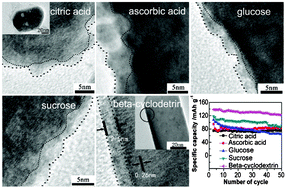Effect of different carbon sources on the electrochemical properties of rod-like LiMnPO4–C nanocomposites
Abstract
Olivine structured LiMnPO4

* Corresponding authors
a
Key Laboratory of Colloid and Interface Chemistry, Ministry of Education, and School of Chemistry and Chemical Engineering, Shandong University, Jinan, P. R. China
E-mail:
xuhuayun@sdu.edu.cn, yangjian@sdu.edu.cn
Fax: +86 531 88364489
Tel: +86 531 88364489
Olivine structured LiMnPO4

 Please wait while we load your content...
Something went wrong. Try again?
Please wait while we load your content...
Something went wrong. Try again?
L. Li, J. Liu, L. Chen, H. Xu, J. Yang and Y. Qian, RSC Adv., 2013, 3, 6847 DOI: 10.1039/C3RA22862B
To request permission to reproduce material from this article, please go to the Copyright Clearance Center request page.
If you are an author contributing to an RSC publication, you do not need to request permission provided correct acknowledgement is given.
If you are the author of this article, you do not need to request permission to reproduce figures and diagrams provided correct acknowledgement is given. If you want to reproduce the whole article in a third-party publication (excluding your thesis/dissertation for which permission is not required) please go to the Copyright Clearance Center request page.
Read more about how to correctly acknowledge RSC content.
 Fetching data from CrossRef.
Fetching data from CrossRef.
This may take some time to load.
Loading related content
